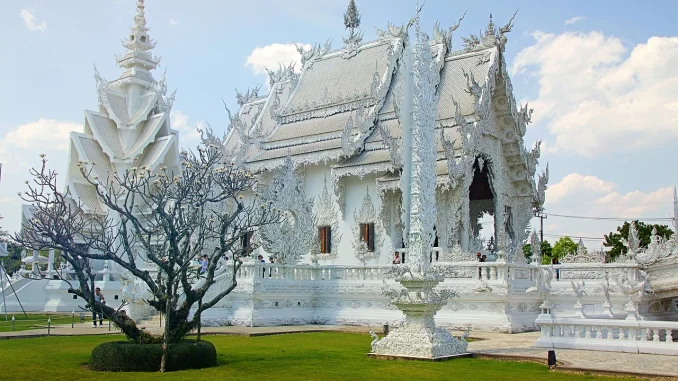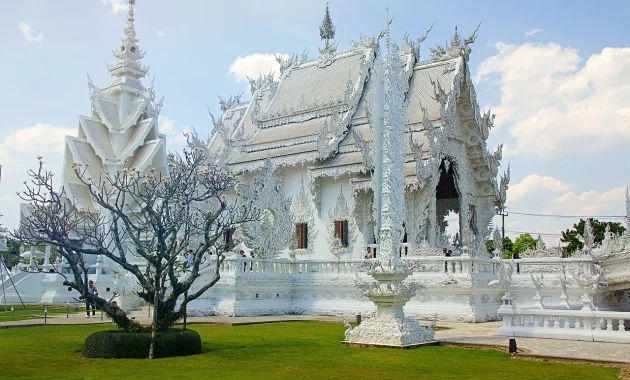
Chiang Rai was founded in 1262 by King Mengrai and served as the capital of the Mengrai Dynasty. Its historical roots run deep, with influences from various hill tribes and neighboring regions. This blend of cultures has shaped Chiang Rai into a vibrant city with a unique identity.
Top Attractions in Chiang Rai
The White Temple (Wat Rong Khun)
Overview: The White Temple is one of the most iconic landmarks in Chiang Rai, designed by the renowned Thai artist Chalermchai Kositpipat.
Unique Features: Unlike any traditional temple, Wat Rong Khun is an artistic masterpiece with its dazzling white exterior, intricate details, and surreal sculptures. The temple represents the artist’s vision of heaven, hell, and everything in between.
The Blue Temple (Wat Rong Suea Ten)
Overview: Another stunning temple, the Blue Temple, is known for its striking blue color and elaborate design.
Unique Features: The temple’s interior is adorned with vivid blue hues, intricate murals, and a majestic white Buddha statue, making it a feast for the eyes.
Baan Dam Museum (The Black House)
Overview: Created by the late artist Thawan Duchanee, Baan Dam is a collection of over 40 black houses showcasing eclectic art pieces.
Unique Features: The museum’s dark and mysterious ambiance, combined with its unusual exhibits, provides a stark contrast to the White and Blue Temples.
The Golden Triangle
Overview: The Golden Triangle is where the borders of Thailand, Laos, and Myanmar converge.
Historical Importance: Once infamous for its opium trade, the area is now a fascinating historical site with a museum that delves into its complex past.
Natural Wonders in Chiang Rai
Phu Chi Fa
Overview: Phu Chi Fa is a scenic mountain area offering breathtaking views, especially at sunrise.
Best Times to Visit: Early morning is the best time to witness the sea of mist and stunning sunrise over the mountains.
Doi Mae Salong
Overview: Known for its picturesque tea plantations and Chinese-influenced culture, Doi Mae Salong is a peaceful retreat.
Activities to Do: Enjoy tea tasting, explore the local markets, and visit the historic temples.
Khun Korn Waterfall
Overview: Khun Korn Waterfall is the tallest waterfall in Chiang Rai, nestled within a lush forest.
How to Get There: A short trek through the forest will lead you to this majestic waterfall, perfect for a refreshing dip.
Experiencing Local Culture
Chiang Rai Night Bazaar
Overview: The night bazaar is a bustling market offering a mix of local crafts, street food, and live entertainment.
What to Expect: Stroll through the stalls, sample delicious local snacks, and enjoy traditional performances.
Traditional Lanna Cuisine
Must-Try Dishes: Don’t miss out on Khao Soi (curry noodle soup), Sai Oua (northern Thai sausage), and Nam Ngiao (spicy noodle soup).
Recommended Restaurants: Some popular spots include Lu Lam and Phu Lae.
Hill Tribe Villages
Overview: Visiting hill tribe villages offers a glimpse into the traditional lifestyles of the Akha, Lahu, and Karen tribes.
Cultural Experiences: Participate in traditional crafts, learn about their customs, and support local artisans by purchasing handmade goods.
Adventure Activities in Chiang Rai
Trekking and Hiking
Popular Trails: Explore trails in Doi Mae Salong, Phu Chi Fa, and the surrounding hills.
Scenic Views: Enjoy panoramic views, lush forests, and encounters with wildlife.
Cycling Tours
Best Routes: Cycle through the countryside, along the Mae Kok River, and around tea plantations.
What to Expect: Experience the rural charm of Chiang Rai and its picturesque landscapes.
River Cruises
Options and What to Expect: Take a leisurely cruise on the Mae Kok River, visiting local villages and enjoying the serene surroundings.

The Best Time to Visit Chiang Rai
Climate and Seasons: Chiang Rai has a tropical climate with three main seasons – cool (November to February), hot (March to May), and rainy (June to October).
Recommended Times for Different Activities: The cool season is ideal for outdoor activities, while the rainy season offers lush scenery and fewer tourists.
How to Get to Chiang Rai
Transportation Options: Chiang Rai is accessible by plane, bus, or car.
Travel Tips: Direct flights from Bangkok to Chiang Rai are available, or you can take a scenic bus ride through northern Thailand.
Where to Stay in Chiang Rai
Luxury Accommodations
- Le Meridien Chiang Rai Resort: A riverside retreat with modern amenities.
- The Legend Chiang Rai Boutique River Resort & Spa: Offers a blend of luxury and traditional Thai architecture.
Budget-Friendly Options
- Mercy Hostel: A popular choice for backpackers.
- Connect Hostel: Affordable and centrally located.
Unique Stays
- Bamboo Nest de Chiang Rai: An eco-friendly retreat in the mountains.
- Phu Chaisai Mountain Resort: A charming resort with a focus on wellness and sustainability.
Shopping in Chiang Rai
Local Markets
- Central Market: A bustling market with fresh produce and local goods.
- Hill Tribe Villages: Purchase handmade crafts and textiles directly from the artisans.
Handicrafts and Souvenirs
- Recommended Buys: Traditional clothing, silver jewelry, and bamboo products.
Festivals and Events
Major Festivals
- Chiang Rai Flower Festival: A vibrant display of flowers and cultural performances.
- Songkran Festival: Celebrate the Thai New Year with water fights and traditional rituals.
Cultural Events
- King Mengrai Festival: Honoring the founder of Chiang Rai with parades and ceremonies.
- Loy Krathong Festival: Release floating lanterns on the river in a beautiful and symbolic ceremony.
Day Trips from Chiang Rai
Recommended Destinations
- Mae Sai: The northernmost point of Thailand and a gateway to Myanmar.
- Chiang Saen: An ancient city with historical ruins and the Golden Triangle viewpoint.
What to See and Do
- Mae Sai: Explore the border market and visit Wat Tham Pla (Monkey Temple).
- Chiang Saen: Visit the Chiang Saen National Museum and take a boat trip along the Mekong River.
Sustainable Tourism in Chiang Rai
Eco-Friendly Practices
- Travel Responsibly: Minimize your environmental impact by reducing waste and conserving water.
- Support Local Communities: Choose locally-owned accommodations and tour operators.
Insider Tips for Travelers
Local Insights
- Learn Basic Thai Phrases: It helps to know a few Thai phrases to communicate with locals.
- Respect Local Customs: Dress modestly when visiting temples and be mindful of cultural etiquette.
Do’s and Don’ts
- Do: Try local food, interact with locals, and explore off-the-beaten-path destinations.
- Don’t: Litter, disrespect religious sites, or engage in unethical tourism practices.